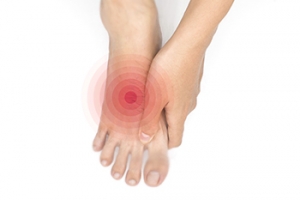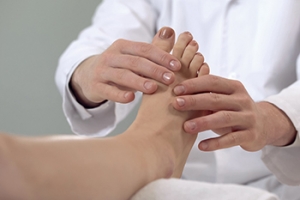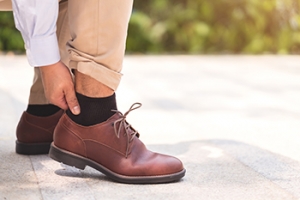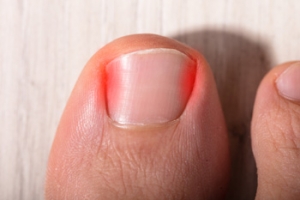Connect With Us
Blogs
Super User
Sesamoiditis
Sesamoiditis is a condition that affects the joint that is just behind the big toe in the area known as the ball of the foot. It is most common in younger people and people who have just begun an exercise program. Since the sesamoid bones are like a pulley controlling the big toe, they can rub against each other and cause a gradual onset of pain. Pain may also be caused by the inflammation of tendons surrounding the bones. If ignored, sesamoiditis can lead to other, more serious problems such as severe irritation and fractures of the bones.
The cause of sesamoiditis is sudden increase in activity. The ball of your foot acts as a springboard to help you lift off when you are jogging or running. Sudden increase in the use of these bones or the tendon that controls them can cause irritation. The tendon then begins to develop inflammation and the joint begins to swell. People with smaller, bonier feet or those with a high arch are typically more susceptible to this condition.
Sesamoiditis is fairly simple to diagnose since the symptoms have a gradual onset rather than a sudden impact. The symptoms begin with slight irritation around the joint shortly after the increase in activity. The discomfort eventually turns to pain with light swelling and possibly redness. Although redness or bruising are rare, this may be a symptom. After each session of exercising, the aggravated joint becomes more irritated and increases into a very intense throbbing.
Treatment for sesamoiditis can vary depending on the severity of the situation. However, treatment is almost always approached in a noninvasive way. For a case that is just beginning the doctor may recommend a very strict rest period that will limit the activity allowed on the joint. If you must be active, a recommendation for as modified shoe or insole, along with bandaging and immobilizing the big toe will be made to ensure that pressure is not placed on the joint. For severe cases, it is typically recommended that the joint and the big toe be completely immobilized to allow adequate time to heal. Ice and an over the counter anti-inflammatory may can help with the pain and discomfort while you are at rest.
When you return to your regular exercise activities, it is recommended that you use an insole that will allow even distribution of impact to your entire foot, rather than just the balls of your foot. This will prevent further aggravation of the injury.
Diabetes and Severe Foot Problems

Foot problems are the most common reason diabetics are hospitalized. Diabetics might have slow-healing wounds, infections, or other foot issues they may not even be aware of. This could be due to loss of sensation in the feet known as neuropathy, which is from poor blood flow to the lower extremities. Amputation of a limb could be the result if a wound develops, becomes infected, and is beyond salvaging. Diabetics can also get peripheral arterial disease, or PAD, which can lead to leg arteries becoming too clogged to restore blood flow to the feet. If you are a diabetic, practice proper foot care which includes washing, drying, and moisturizing the feet every day and checking them for wounds or infections regularly. Practicing good foot care also includes scheduling visits with a podiatrist who can help you make sure that diabetes is not causing any other foot conditions in the feet. If you or a loved one has diabetes, it is strongly suggested that you consult with a podiatrist.
Diabetic Limb Salvage
Diabetic limb salvage can be an effective way in preventing the need for limb amputation. If you have a foot ulcer and diabetes, consult with one of our podiatrists from Brondon Foot and Ankle. Our doctors will assess your condition and provide you with quality foot and ankle treatment.
What Is Diabetic Limb Salvage?
Diabetic limb salvage is the attempt of saving a limb, such as the foot, that has an infected ulcer, from amputation. Podiatrists also try to make sure that there is enough function in the foot after the salvage that it is still usable. Those with diabetes experience poor blood circulation, which prevents proper healing of an ulcer. If the ulcer is left uncheck, it could become infected, which could result in the need for amputation.
Diabetes is the number one cause of non-traumatic amputations in the United States. Amputation has been found to lead to higher mortality rates. This translates into higher healthcare costs, and a reduced quality of life and mobility for amputees. Podiatrists have attempted to increase the prevalence of limb salvage in an attempt to solve these issues.
Diagnosis and Treatment
Limb salvage teams have grown in recent years that utilize a number of different treatments to save the infected limb. This includes podiatrists that specialize in wound care, rehabilitation, orthotics, and surgery. Through a combination of these methods, limb salvage has been found to be an effective treatment for infected limbs, and as an alternative to amputation. Podiatrists will first evaluate the potential for limb salvage and determine if the limb can be saved or must be amputated.
If you have any questions, please feel free to contact our office located in Centerville, OH . We offer the newest diagnostic and treatment technologies for all your foot care needs.
Diabetic Limb Salvage
Limb salvage is a procedure that involves saving a lower extremity from amputation. In podiatry, limb amputation often occurs as a result of diabetes. The fundamental goal of limb salvage is to restore and maintain stability and movement of the affected lower extremity.
The procedure typically involves removing the diseased tissue and a small portion of the surrounding healthy tissue, as well as the removal of any affected bone if necessary. If bone is removed it is then replaced with prostheses, or synthetic metal rods or plates, or grafts from either the patient’s body or a donor. Limb salvage is typically the preferred choice of procedure over amputation, as the procedure preserves both the patient’s appearance and allows for the greatest possible degree of function in the affected limb.
Upon diagnosis and determining that limb salvage is the appropriate treatment, the podiatrist may enlist the help of a physical and/or occupational therapist to prepare the patient for surgery by introducing various muscle-strengthening, walking, and range of motion exercises. Such exercises may be continued as rehabilitation post-procedure.
All About the Metatarsal Bones

Although you may not always think about it, there are many different bones in your feet that play important roles and are constantly supporting your every movement. The metatarsal bones are one example of critical bones that are located in the feet. There are five metatarsals that comprise the arches of your feet. This makes them play an important role in bearing and supporting weight. The 1st metatarsal bone is the thickest bone, and consequently, it bears more weight than the other metatarsals. It is important to note that although fractures are rare, an individual can fracture the metatarsals when large objects that are heavy fall on them. Hallux Valgus, or bunions, is also a condition that can negatively impact the 1st metatarsal. If you want to learn more about the metatarsal bones, or are concerned about your metatarsals, contact a podiatrist today.
If you have any concerns about your feet, contact one of our podiatrists from Brondon Foot and Ankle. Our doctors can provide the care you need to keep you pain-free and on your feet.
Biomechanics in Podiatry
Podiatric biomechanics is a particular sector of specialty podiatry with licensed practitioners who are trained to diagnose and treat conditions affecting the foot, ankle and lower leg. Biomechanics deals with the forces that act against the body, causing an interference with the biological structures. It focuses on the movement of the ankle, the foot and the forces that interact with them.
A History of Biomechanics
- Biomechanics dates back to the BC era in Egypt where evidence of professional foot care has been recorded.
- In 1974, biomechanics gained a higher profile from the studies of Merton Root, who claimed that by changing or controlling the forces between the ankle and the foot, corrections or conditions could be implemented to gain strength and coordination in the area.
Modern technological improvements are based on past theories and therapeutic processes that provide a better understanding of podiatric concepts for biomechanics. Computers can provide accurate information about the forces and patterns of the feet and lower legs.
Understanding biomechanics of the feet can help improve and eliminate pain, stopping further stress to the foot.
If you have any questions please feel free to contact our office located in Centerville, OH . We offer the newest diagnostic and treatment technologies for all your foot and ankle needs.
Many People Experience Foot Pain

Many people experience foot pain at some point in their lives. Research has indicated that approximately 75,000 miles have been walked by the age of 50, and the likelihood is high that foot pain can develop. A common foot condition is athlete’s foot, and this is contagious. It is caused by a fungus that lives and thrives in warm and moist environments including shower room floors, public swimming pools, and locker rooms. Blisters can be quite uncomfortable and may develop from wearing shoes that do not fit correctly. A bunion is defined as a bony lump on the side of the big toe and is considered to be a deformity. Bunions can occur as a result of genetic factors or from wearing shoes that do not have adequate room for the toes to move freely. If the bunion is severe, surgery may be required for permanent removal. Another popular ailment is heel pain, which is most frequently caused by plantar fasciitis. Children can also develop heel pain known as Sever’s disease. Gout is said to be more prevalent among men and typically results from having excess uric acid in the blood. This causes crystals to form in the joints of the big toe and can cause debilitating pain. If you have any foot pain, it is strongly advised that you are under the care of a podiatrist who can properly diagnose and treat your condition.
Foot Pain
Foot pain can be extremely painful and debilitating. If you have a foot pain, consult with one of our podiatrists from Brondon Foot and Ankle. Our doctors will assess your condition and provide you with quality foot and ankle treatment.
Causes
Foot pain is a very broad condition that could be caused by one or more ailments. The most common include:
- Bunions
- Hammertoes
- Plantar Fasciitis
- Bone Spurs
- Corns
- Tarsal Tunnel Syndrome
- Ingrown Toenails
- Arthritis (such as Gout, Rheumatoid, and Osteoarthritis)
- Flat Feet
- Injury (from stress fractures, broken toe, foot, ankle, Achilles tendon ruptures, and sprains)
- And more
Diagnosis
To figure out the cause of foot pain, podiatrists utilize several different methods. This can range from simple visual inspections and sensation tests to X-rays and MRI scans. Prior medical history, family medical history, and any recent physical traumatic events will all be taken into consideration for a proper diagnosis.
Treatment
Treatment depends upon the cause of the foot pain. Whether it is resting, staying off the foot, or having surgery; podiatrists have a number of treatment options available for foot pain.
If you have any questions, please feel free to contact our office located in Centerville, OH . We offer the newest diagnostic and treatment technologies for all your foot care needs.
Elderly and their Feet
While proper foot care is important for everybody, senior citizens have the tendency to be more susceptible to certain foot conditions. The elderly should therefore be well informed about any problems that may arise and about what they can do to properly avoid or treat them.
Some of the most common foot problems seniors are susceptible to include foot ulcers, ingrown toenails, fallen arches, and fungal nails. A foot ulcer is an open sore on the foot and can be a result of diabetes and decreased sensation in the feet. An ingrown toenail is defined as when the nail grows into the side of the toe. Fallen arches are indicated by the instep of the foot collapsing. A fungal nails is a condition that results in deformed and discolored toenails.
In order to avoid these conditions it is recommended that the feet be inspected by the patient on a regular basis. If these inspections are carried out routinely, there is a good likelihood that problems can be identified before they become severe, or can even be avoided altogether. If any abnormality is discovered, it is important that the individual consult a podiatrist for diagnosis and information on treatment options.
Proper foot hygiene is also important. Making sure that you always have clean, dry socks on can be a major deterrent to many different problems including bacterial infections, foot odor, and certain types of fungus. Wet feet are a major cause of many of these problems. If your socks get wet, it is important to change them. Walking around in wet socks may not only lead to various infections, but can irritate the skin and result in a number of various complications. Clean, dry feet are less likely to be affected by fungal and other infections.
As people age, the fat present on your feet begins to deteriorate. The protective nature of this fat keeps the feet healthy by providing a barrier between your bones and the ground. This also aids in giving the skin on the feet a certain amount of elasticity. This is one factor that causes elderly people to develop some serious foot issues. Foot moisturizers can be helpful to avoid certain problems associated with this. However, water-based moisturizers do not work as well for elderly people as they do for the young. Instead, it is more effective to use an emollient instead. An emollient is effective because it binds the water in the foot, keeping it from becoming absorbed too readily which will result in dry skin. Emollients also have a special property called occlusion, which provides a layer of oil on the skin. This layer prevents the foot from drying up and can be very effective in treating dry skin disorders. If you can keep the skin on your feet healthy, this will substantially reduce the number of foot problems you will encounter in old age.
Proper footwear is another way to keep feet healthy. Shoes that fit well and provide proper support help prevent ingrown toenails and fallen arches.
Certain medical conditions such as diabetes or poor blood circulation increase the risk for foot issues. For individuals with any of these conditions it is extremely important to conduct regular foot inspections to make sure that there are no sores or infections present.
Chef’s Feet

Professional chefs spend many hours a week on their feet cooking. Their days often involve a continuous day of standing, walking, bending, lifting, and turning at odd angles. Being on one’s feet so much will eventually take a toll. It might start with sore feet at the end of the day but often gradually starts to involve other parts of the body as everything is interconnected. It is important for anyone in this profession, and any other job that requires long hours of standing, to take proper care of their feet. If not, one will be in constant pain, productivity will be impacted, and the passion for cooking will take a back seat to aches and pains. A cook can delay or diminish foot pain by doing some simple things, including wearing shoes that fit well, are supportive, and have proper cushioning. Other tips are lifting properly and not more than can be handled, and wearing white socks, because colored socks have dye that can seep into pores when one sweats. Sitting (at least when eating) to take some of the pressure off the feet, as well as staying active and stretching when not working to keep limber may also help. Do as much as you can to take care of your feet if you are working on your feet all day. If you cannot get on top of the pain yourself, see a podiatrist for additional tips and treatment.
While working on the feet, it is important to take the proper care of them. For more information about working on your feet, contact one of our podiatrists from Brondon Foot and Ankle. Our doctors will treat your foot and ankle needs.
Working on Your Feet
Standing on your feet for long periods of time can cause stress and pain in your feet. Your whole body may experience change in terms of posture, back pain, bunions, callouses and or plantar warts. There are ways to avoid these conditions with proper foot care, smart choices and correct posture.
Positive Changes
Negative heeled shoe – Choosing this shoe type places the heel slightly lower than the ball of the foot. These are great for overall foot health. Find shoes that fit you correctly.
Go barefoot – Our feet were not designed to be enclosed for all hours of the day. Try to periodically expose your feet to air.
Eliminate Pain
Foot Exercises – Performing simple exercises, incorporating yoga and doing stretches are beneficial. This will allow increased blood flow to the area and muscles of the foot.
Achilles tendon – Stretching the foot out flat on the floor will relax the calf muscles and tendon. These exercises can be performed almost anywhere. Make sure you add these exercises to your daily regimen.
With a little bit of this information and knowing more about foot health, you will notice changes. Foot stretches and proper footwear will help with pain and prevent further issues.
If you have any questions please feel free to contact our office located in Centerville, OH . We offer the newest diagnostic and treatment technologies for all your foot and ankle needs.
How to Handle a Long Work Day on Your Feet
In 2014, the American Podiatric Medical Association surveyed 1,000 American adults and found that half of all respondents lived with foot pain. Fortunately, there are ways to avoid foot problems such as following a daily footcare routine and wearing proper footwear at work.
If you have a job that requires you to be on your feet, it is best that you do not wear flat sole shoes. Your heel should be slightly elevated (less than 2 inches, but at least ¼-inch) if you are going to be standing for a prolonged period. You should also make sure that the shoes you wear are not too small. Tight shoes may cut off circulation to your feet, which will result in pain and blisters. It is always best to purchase fitted shoes later in the day, because the feet tend to swell as the day progresses. It may also be helpful to buy shoes a half size larger if you plan on wearing custom orthotics or arch supports.
Your muscles may become stiff when you are constantly standing up. It is important to take breaks every hour to stretch and relax. One tip is to perform calf raises, because this exercise will help improve your circulation. To perform this stretch, you first need to stand on the edge of a step with your abdominal muscles pulled inward. You then need to grip the step with the balls of your feet with your heels hanging over the edge. Next, try to raise your heels above the step by a few inches while standing on your tiptoes; hold this pose for a second. You should then lower your heels back even to the platform. These calf raises should be done ten times for full effectiveness.
You should also take care of your feet while you are at home. One of the best ways to prepare your feet for a long day of work is to soak them in ice water. Doing so for 20 minutes will help fight the swelling and inflammation that results from being on your feet at work.
Nevertheless, if you are experiencing pain in your feet, you should seek help from your podiatrist. Your doctor will help treat any ailments you may have in addition to helping you prevent any other ailments from developing in the future.
When an Ingrown Toenail Becomes Dangerous
I ngrown toenails can occur in individuals of all ages when the side of the nail digs into the skin. This condition is most prevalent in one’s big toe and will cause pain, discomfort, and redness where the ingrown nail meets the skin. Although the causes of ingrown toenails are varied, this condition frequently occurs due to improper nail care. If a toenail is cut too short, for example, the skin on the side of the nail can grow over top of the nail, eventually making it ingrown. Ingrown toenails can also develop when a toenail completely falls off following a serious foot injury or when the nail is severely ripped or misshapen. Some ingrown toenails—notably, milder ones—do not require immediate medical attention. However, making yourself aware of ingrown toenails is important to maintaining healthy feet because this condition can quickly become dangerous. Ingrown toenails may sometimes become infected, producing pus, swelling, warmness, and even unpleasant odors where the ingrown nail meets the skin. Letting such an infection go untreated may exacerbate the condition and the pain felt in the toenail. Upon receiving proper medical attention, your ingrown nail may be cared for by draining pus or removing sections of the ingrown nail. It is suggested you consult with your podiatrist if you feel an ingrown toenail is getting serious.
ngrown toenails can occur in individuals of all ages when the side of the nail digs into the skin. This condition is most prevalent in one’s big toe and will cause pain, discomfort, and redness where the ingrown nail meets the skin. Although the causes of ingrown toenails are varied, this condition frequently occurs due to improper nail care. If a toenail is cut too short, for example, the skin on the side of the nail can grow over top of the nail, eventually making it ingrown. Ingrown toenails can also develop when a toenail completely falls off following a serious foot injury or when the nail is severely ripped or misshapen. Some ingrown toenails—notably, milder ones—do not require immediate medical attention. However, making yourself aware of ingrown toenails is important to maintaining healthy feet because this condition can quickly become dangerous. Ingrown toenails may sometimes become infected, producing pus, swelling, warmness, and even unpleasant odors where the ingrown nail meets the skin. Letting such an infection go untreated may exacerbate the condition and the pain felt in the toenail. Upon receiving proper medical attention, your ingrown nail may be cared for by draining pus or removing sections of the ingrown nail. It is suggested you consult with your podiatrist if you feel an ingrown toenail is getting serious.
Ingrown toenails can become painful if they are not treated properly. For more information about ingrown toenails, contact one of our podiatrists of Brondon Foot and Ankle. Our doctors can provide the care you need to keep you pain-free and on your feet.
Ingrown Toenails
Ingrown toenails occur when a toenail grows sideways into the bed of the nail, causing pain, swelling, and possibly infection.
Causes
- Bacterial infections
- Improper nail cutting such as cutting it too short or not straight across
- Trauma to the toe, such as stubbing, which causes the nail to grow back irregularly
- Ill-fitting shoes that bunch the toes too close together
- Genetic predisposition
Prevention
Because ingrown toenails are not something found outside of shoe-wearing cultures, going barefoot as often as possible will decrease the likeliness of developing ingrown toenails. Wearing proper fitting shoes and using proper cutting techniques will also help decrease your risk of developing ingrown toenails.
Treatment
Ingrown toenails are a very treatable foot condition. In minor cases, soaking the affected area in salt or antibacterial soaps will not only help with the ingrown nail itself, but also help prevent any infections from occurring. In more severe cases, surgery is an option. In either case, speaking to your podiatrist about this condition will help you get a better understanding of specific treatment options that are right for you.
If you have any questions please feel free to contact our office located in Centerville, OH . We offer the newest diagnostic and treatment technologies for all your foot and ankle needs.







